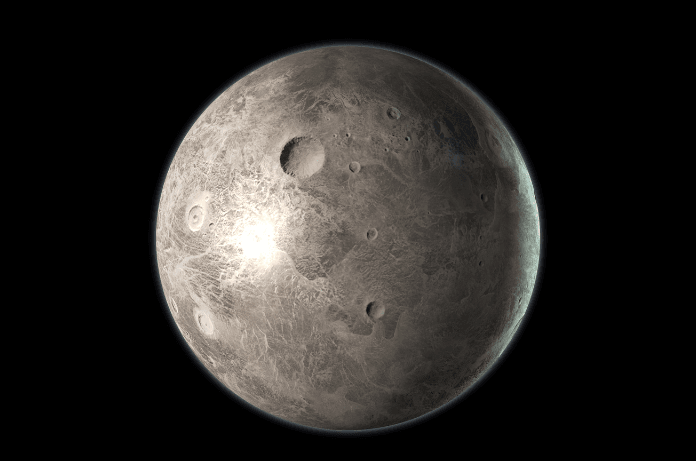What if Earth had a second moon, even if just for a short while? For the past two months, a small asteroid known as 2024 PT5 has graced our skies, behaving like a “mini moon” on a fleeting cosmic journey near Earth. Although not technically a moon, this intriguing asteroid has followed a unique, horseshoe-shaped path influenced by Earth’s gravity. Now, as the Sun’s gravitational pull overpowers our planet’s hold, this fascinating visitor is preparing to drift away. But this isn’t the last we’ll see of 2024 PT5—it’s set to return for a close encounter in January 2025.
A Cosmic Companion
2024 PT5 is tiny compared to Earth’s actual Moon. It measures just 10 meters (33 feet) in diameter. Currently, more than 3.5 million kilometers (2 million miles) away, and it’s too small and faint to be seen without a powerful telescope. Its presence was first noticed in August 2023, but it wasn’t until late September that it came under Earth’s gravitational influence, beginning a temporary dance with our planet.
Despite its proximity, the asteroid has never been fully captured by Earth’s gravity. Instead, it has followed a semi-orbit around the planet, resembling a celestial partner that never quite settles down. Astrophysicist brothers Raul and Carlos de la Fuente Marcos of Madrid’s Complutense University were among the first to identify this “mini moon behavior.” Using telescopes based in the Canary Islands, the duo collaborated with researchers to conduct hundreds of observations, providing crucial insights into the asteroid’s trajectory and characteristics.
The Final Farewell—For Now
Today, 2024 PT5 will part ways with Earth as the Sun’s stronger gravitational pull draws it away. This cosmic farewell, however, is far from permanent. The asteroid will return in January 2025 when it will pass as close as 1.8 million kilometers (1.1 million miles) from Earth—almost five times the distance to the Moon. Even at this range, scientists eagerly anticipate the visit as an opportunity to learn more about this enigmatic object.

By January 2024 PT5 will be moving at more than twice the speed it traveled in September. Hence, it is impossible for Earth’s gravity to influence its path enough for another temporary orbit. Instead, it will make a quick flyby, zooming deeper into the solar system after the encounter. Current data suggest it will not return until 2055, at which point it might again perform a brief celestial dance with Earth.
Unlocking Secrets of Its Origin
What makes 2024 PT5 particularly intriguing is its potential origin story. One hypothesis suggests it might be a fragment of the Moon itself. A few scientists said it could be a piece of lunar rock ejected into space during an asteroid impact that created a crater on the Moon’s surface. Studying such objects provides valuable insights not just into the dynamics of near-Earth objects (NEOs) but also into the history of celestial collisions that have shaped our solar system.
In January, NASA plans to closely observe 2024 PT5 using the Goldstone Solar System Radar, a state-of-the-art facility located in California’s Mojave Desert. Part of NASA’s Deep Space Network, the radar will allow scientists to gather detailed data on the asteroid’s size, shape, composition, and surface features. These observations could help confirm its origin and provide valuable data for future studies of similar objects.
The mini moon is not Quite a Moon
While often referred to as a “mini moon,” 2024 PT5 doesn’t meet the criteria to be classified as an actual moon. Moons are celestial bodies that are fully captured by a planet’s gravity. They follow a stable orbit. In contrast, 2024 PT5’s movement around Earth has been more of a fleeting gravitational interaction, resembling a cosmic hitchhiker rather than a permanent resident.
However, this doesn’t diminish its significance. Temporary companions like 2024 PT5 are rare and offer scientists a chance to study the dynamic interactions between Earth and other objects in space. By tracking such asteroids, researchers can also refine models used to predict the behavior of potentially hazardous near-Earth objects.
The Long Goodbye to Mini Moon
2024 PT5’s journey underscores the vastness and complexity of our solar system. For now, the asteroid will continue orbiting the Sun, taking with it the mysteries of its origin and its brief interaction with Earth. While its return in January promises to be a scientific highlight, its next visit in 2055 may offer even more opportunities for discovery as technology continues to advance.
For Earth, 2024 PT5 serves as a reminder of the constant motion and interaction between celestial bodies. Its fleeting presence may not have had the same impact as larger cosmic events, but it highlights the importance of studying even the smallest visitors to our planetary neighborhood.
A Legacy Worth Watching
As 2024 PT5 departs, scientists eagerly await its return and the insights it may offer. The asteroid’s story is far from over, and its temporary role as a “mini moon” adds a fascinating chapter to humanity’s ongoing exploration of the cosmos. With tools like NASA’s radar and the dedication of astrophysicists around the world, objects like the 2024 PT5 remind us of the boundless curiosity and wonder inspired by the universe’s smallest mysteries.
In a cosmos filled with infinite possibilities, even a brief encounter with a wandering asteroid can deepen our understanding of the intricate dance of gravity and the forces that shape our solar system. For now, Earth bids farewell to its temporary companion, knowing it will see it again soon—if only for a short while.

